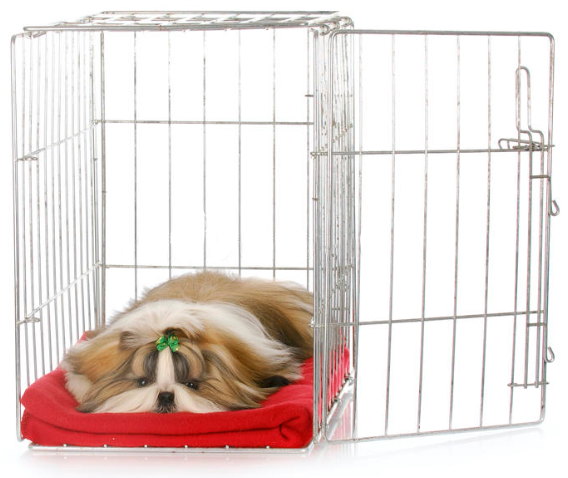EXPERT DOG TRAINING | CENTRAL MA
CRATE TRAINING
Crate training is one of the best things that you can do for your dog. It is also a great way to start off on the right foot for obedience training. You have to prepare yourself far more than you have to prepare your dog for this training. To most people, the crate conjures up ideas of a jail or punishment for your dog. The most difficult part of this training is to help owners realize the difference in the dog’s point of view.
We have to realize that a dog looks at a crate as a safe comfortable place to rest and not as a jail. Crate training is the way to go!
Scientists and doctors and animal rights groups have studied crate training for years. The one thing that they can all agree on is that it is NOT inhumane or cruel to your dog. Actually just the opposite applies. A crate provides a den or a hiding spot where the dog feels secure. It also provides a place where he can sleep, rest, or hide toys. Dogs live their lives by using their instincts, and having a den is one of these instincts.
The biggest hurdle that you will encounter when crate training, is the crying. It is true that when your dog is crying he is trying to tell you something. What the dog is telling you is that he is bored and maybe lonely. There are several ways to get past the crying stage of this, but first you have to understand what is happening.
Dogs are pack animals. Generally they do not like to be by them selves. When they are separated from the pack (you and your family), they start to get anxious. Remember, that a pack of dogs sleep in a den usually, not just one. So this new concept, just like every new concept, takes a little time to get used to. HAVE PATIENCE. It is up to you to make the crate positive. Never make the crate the place that the dog goes after he has been corrected. This needs to be a fun happy place for the dog. There are two basic types of crates. One is made of plastic or fiberglass and has slotted holes on the sides and a metal door on one end. This type of crate is thought to give the dog more of a sense of security. It is darker and has less ventilation.
The other style is the metal crate. It is made of metal bars, has plenty of light and ventilation. This gives the dog less of a security sense, but more interaction with what is going on around it. You should keep in mind the size that your dog will grow to and buy for that size. Any smaller and you will have to buy more than one crate. Any larger and your dog will be able to go to the bathroom in one end of the crate and still sleep at the other and this will inhibit house breaking.
The crate should be in a high traffic area during the day, so that the dog has social contact. Dogs thrive off of contact. Take it slow. Put your dog in the kennel for minutes at first.
1. Lure him in with a treat and leave the door open. When he gets comfortable with this, let him eat a meal in the crate, putting the bowl in the back of the crate and closing the door.
2. After he becomes totally comfortable with this, close the door and lock it.
3. Make it as comfortable as you can for the dog, not for you. Some dogs like fluffy pillows and blankets, some dogs just eat them and end up being fine with nothing in the crate but a toy. 4. Never take the dog out of the kennel when they throw a fit. Instead, wait until they calm down, and make the exit a positive association. If you give in to the dog, you will be reinforcing a behavior that the dog will associate crying and barking with being let out and he will do this until it is corrected.
The first night that you begin crate training, expect that he will whine and whimper. It is simply telling you that it wants attention. You will eventually learn the difference between a cry for attention and a cry to go to the bathroom. If you follow a schedule for feeding and going out, then it will be much easier to time when you take the dog out.
Try these helpful steps. If you need more assistance, Absolute K-9 Solutions. Proudly serving Massachusetts and beyond.
We always cover any nagging behavior problems that you are experiencing as well, such as: Housebreaking, Jumping, Barking, Nipping and Biting, Destructive Chewing.
We also extensively cover the ins and outs of Housebreaking and Crate Training your dog.
TRAINING SERVICES QUICK LINKS
Personal Training
Advanced Off Leash
Custom Dog Training
Board & Train

HOUSE BREAKING
Serving Massachusetts and beyond.
Prices and Services listed on website are subject to change without notice
ABSOLUTE K9 SOLUTIONS
Massachusetts Dog Training Services
® 2001 - 2023
236 Lunenburg St. Suite B
Fitchburg MA 01420
1-978-833-1845
WEBSITE DESIGN & MAINTENANCE
Kreative Dezign |
978.466.9995
ABSOLUTE K9 SOLUTIONS
Massachusetts Dog Training Services ® 2001 - 2023
236 Lunenburg St. Fitchburg MA 01420
1-978-833-1845
WEBSITE DESIGN & MAINTENANCE
KREATIVE DEZIGN | 978.466.9995



